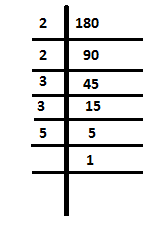
Express the number 180 as a product of its prime factors.
Answer
568.2k+ views
Hint:
Here the given number is a composite number but we have to express it as a product of prime factors.So we will divide the number with prime numbers only and then their product will be our answer.
Complete step by step solution:
The given number is 180.
Let’s use the prime factorization method.

Thus 180 \[ = 2 \times 2 \times 3 \times 3 \times 5\]
Additional information:
1) Prime factorization is the method used to find the H.C.F. of numbers.
2) In this method, the number is broken down or is expressed in the form of the product of prime numbers only.
3) The prime numbers can be repeated if required.
4) Factors can be defined as the numbers which when divided the respective number leaves zero remainders.
5) Factors are not necessarily prime numbers but prime factors are only prime numbers.
6) Prime numbers are the numbers that are divisible by one and the number itself.
7) There are two methods involved in the prime factorization
7.1) Division method
7.2) Factor tree method.
8) All even numbers have 2 as one of their factors compulsorily.
9) If a number is having either 0 or 5 in its units place then 5 is one of its fixed factors
10) Numbers ending with 0 have 2,5,10 as their factor.
11) Factors are never decimals or fractions.
12) The smallest factor of every number is 1.
Note:
The prime numbers can be repeated if required. Factors can be defined as the numbers which when divided the respective number leaves zero remainder. Factors are not necessarily prime numbers but prime factors are only prime numbers.
Here the given number is a composite number but we have to express it as a product of prime factors.So we will divide the number with prime numbers only and then their product will be our answer.
Complete step by step solution:
The given number is 180.
Let’s use the prime factorization method.

Thus 180 \[ = 2 \times 2 \times 3 \times 3 \times 5\]
Additional information:
1) Prime factorization is the method used to find the H.C.F. of numbers.
2) In this method, the number is broken down or is expressed in the form of the product of prime numbers only.
3) The prime numbers can be repeated if required.
4) Factors can be defined as the numbers which when divided the respective number leaves zero remainders.
5) Factors are not necessarily prime numbers but prime factors are only prime numbers.
6) Prime numbers are the numbers that are divisible by one and the number itself.
7) There are two methods involved in the prime factorization
7.1) Division method
7.2) Factor tree method.
8) All even numbers have 2 as one of their factors compulsorily.
9) If a number is having either 0 or 5 in its units place then 5 is one of its fixed factors
10) Numbers ending with 0 have 2,5,10 as their factor.
11) Factors are never decimals or fractions.
12) The smallest factor of every number is 1.
Note:
The prime numbers can be repeated if required. Factors can be defined as the numbers which when divided the respective number leaves zero remainder. Factors are not necessarily prime numbers but prime factors are only prime numbers.
Recently Updated Pages
Master Class 12 Business Studies: Engaging Questions & Answers for Success

Master Class 12 Economics: Engaging Questions & Answers for Success

Master Class 12 English: Engaging Questions & Answers for Success

Master Class 12 Maths: Engaging Questions & Answers for Success

Master Class 12 Social Science: Engaging Questions & Answers for Success

Master Class 12 Chemistry: Engaging Questions & Answers for Success

Trending doubts
Give 10 examples for herbs , shrubs , climbers , creepers

Four bells toll together at 900am They toll after 7811 class 6 maths CBSE

What is BLO What is the full form of BLO class 8 social science CBSE

What is meant by exothermic and endothermic reactions class 11 chemistry CBSE

Which places in India experience sunrise first and class 9 social science CBSE

Which animal has three hearts class 11 biology CBSE





